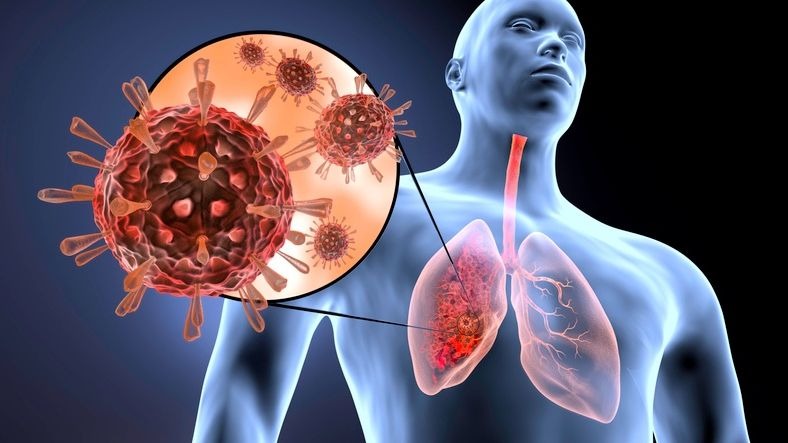Lung infection: a guide to this disease
Caution : You must consult your doctor for your health. This page presents only a personal and alternative point of view which should not be considered as an attempt to prescribe medicine.
When we talk about chronic pulmonary infection, we are referring to one or more infectious pathologies located in the lungs.
Although it is usually mild to the body, a lung infection can sometimes be a source of many complications.
How then to recognize it? What are the symptoms and treatments?

These are so many questions to ask about this disease.
Causes of a chronic lung infection
In most cases, viruses or bacteria are the cause of lung infections.
This is the case, for example, with the flu virus or the bacteria that cause pneumonia: pneumococcus.
Usually, a lung infection occurs when its pathogens (viruses or bacteria) enter the body.
These will then settle in the respiratory system to develop in the lungs.
There are also rare forms of lung infection caused by parasites.
This is the case, for example, with pneumocystosis which is caused by microscopic fungi.
It should be noted that the elderly, smokers and children are the most vulnerable people to chronic lung infection.
However, the majority also concerned are people with respiratory pathologies such as: asthma, chronic obstructive pulmonary disease (COPD), respiratory allergies, occupational pneumonia, pulmonary arterial hypertension, etc.
The main categories of pulmonary infection
Lung infections are categorized according to the part of the respiratory system affected.
- Bronchitis: These are characterized by inflammation of the bronchi, which are the ducts carrying air to the lungs.This inflammation makes breathing difficult and promotes the production of mucus.
- Bronchiolitis: This is an acute infection of the bronchioles.Bronchiolitis is most often noticed in infants and children under 2 years old.
- Pneumopathies: they are characterized by inflammation of the deep lung.The infection usually spreads to the alveoli of a lung lobe.This is where the body's exchange of gases (oxygen and carbon dioxide) takes place.
- Broncho-pneumopathies: in the case of an infection affecting the bronchi and pulmonary alveoli.
- Bronchioalveolitis: in cases of infection localized in the bronchioles and pulmonary alveoli.
- Pleurisies: which are infections of the pleura, the membrane that covers the surface of the lungs.They cause severe pain in the chest and chest during deep breaths.
These are all types of lung infections that exist.
Symptoms of a lung infection
It is not easy to find symptoms specific to a given lung infection.
Indeed, depending on the type of infection and its level in the body, the warning symptoms can vary considerably.
However, three main symptoms have been attributed to the presence of a lung infection.
Usually these are:
- regular fatty cough;
- fever;
- and the production of sometimes clear or purulent coughing up mucus.
We can also distinguish additional symptoms such as increased fatigue, severe chest pain or breathing difficulties.
However, some lung infections are characterized by a dry, irregular cough.
How to diagnose and treat it?
In general, to diagnose a simple lung infection, the doctor will have to analyze the different symptoms manifested by the patient.
He will then listen to his breathing in order to get an idea of the current implications on the airways.
For more details in his diagnosis, the doctor may also recommend a chest x-ray or even a CT scan in certain critical cases.
In addition, in less common types, sputum analysis is done to identify the pathogens underlying the infection.
Once diagnosed, the infection can then be adequately treated.
Usually, with a mild viral infection, resting the body is sometimes sufficient.
However, medication can be administered to relieve the various symptoms.
We can also sometimes combine certain natural recipes with rest to strengthen the body and allow it to recover quickly.
For more complex cases, treatment will take into account the severity of the infection and the type of pathogen.
Thus, antibiotics will be used for bacterial lung infections, antivirals for serious viral lung infections and antiparasitics for pulmonary infections with parasitic origins.
Finally, you should know that when a chronic lung infection is quickly diagnosed, it can easily be treated.
Otherwise, it can cause a lot of complications which can lead to hospitalization or even death.
It is therefore necessary to consult a specialist as soon as the first symptoms appear.
❤ The ultimate guide to breathing
Intermittent Breathing : Discover the method to quickly relieve your anxiety and chronic fatigue (positive effects from the first use).Read also :
Previous article : Voluntary hyperventilation: the danger of respiratory alkalosis
Next article : Chronic respiratory infection: what solutions?

